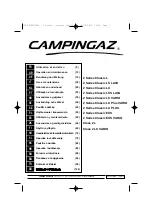
EN
134
EN
135
ADDITIONAL SAFETY INSTRUCTIONS FOR
BATTERY OPERATED DRILL AND DRIVER
a)
Hold power tool by insulated gripping
surfaces, when performing an operation
where the cutting accessory or fastener
may contact hidden wiring.
Cutting ac-
cessory or fasteners contacting a “live”
wire may make exposed metal parts of the
power tool “live” and could give the opera-
tor an electric shock.
b)
Secure the workpiece.
A workpiece
clamped with clamping devices or in a vice
is held more secure than by hand.
c)
Take protective measures when dust
can develop during working that is
harmful to one’s health, combustible or
explosive.
Example: Some dusts are re-
garded as carcinogenic. Wear a dust mask
and work with dust/chip extraction when
connectable.
d)
Before any work on the machine (e.g.,
maintenance, tool change, etc.) as well
as during transport and storage, set the
rotational direction switch to the centre
position.
Unintentional actuation of the On/
Off switch can lead to injuries.
e)
Hold the machine with a firm grip.
High
reaction torque can briefly occur while driv-
ing in and loosening screws.
f)
Switch off the power tool immediately
when the tool inserted jams. Be pre-
pared for high reaction torque that can
cause kickback.
The tool insert jams
when:
- the power tool is subject to overload or
- it becomes wedged in the work piece.
g)
Use a metal detector to determine if
there are gas or water pipes hidden in
the work area or call the local utility
company for assistance before begin-
ning the operation.
Striking or cutting into
a gas line will result in explosion. Water en-
tering an electrical device may cause elec-
trocution.
SAFETY INSTRUCTIONS FOR BATTERY
1. Never use a damaged battery.
2. Do not open the battery. There is a risk of
a short-circuit.
3. Protect the battery from heat, e.g. from
continuous exposure to sunlight, fire, wa-
ter and humidity. There is a risk of explo-
sion.
4. In case of damage and improper use of the
battery, vapours may be emitted. Ventilate
the area and seek medical help in case of
complaints. The vapours can irritate the
respiratory system.
5. Under abusive conditions, liquid may be
ejected from the battery; avoid contact.
If contact accidentally occurs, flush with
water. If liquid contacts eyes, additionally
seek medical help. Liquid ejected from the
battery may cause irritation or burns.
6. Use only original batteries with the volt-
age indicated on the rating plate of your
electric power tool. If other batteries are
used, e.g. imitations, reconditioned bat-
teries or third-party products, there is a
risk of injuries as well as damage caused
by exploding batteries.
7. The battery voltage must match the bat-
tery charging voltage of the battery charg-
er. Otherwise there is a risk of fire and
explosion.
8. Recharge only with the charger specified
by the manufacturer. A charger that is
suitable for one type of battery pack may
create a risk of fire when used with an-
other battery pack.
9. Pointed objects, such as nails or screw-
drivers, or external forces may damage
the battery. This may cause an internal
short-circuit and the battery to burn,
smoke, explode or overheat.
10. When not in use, keep the battery away
from paper-clips, coins, keys, nails,
screws, or other small metal objects, that
can cause a short-circuit at the charging
contacts.
11. Used batteries must be disposed of safely
and correctly.







































